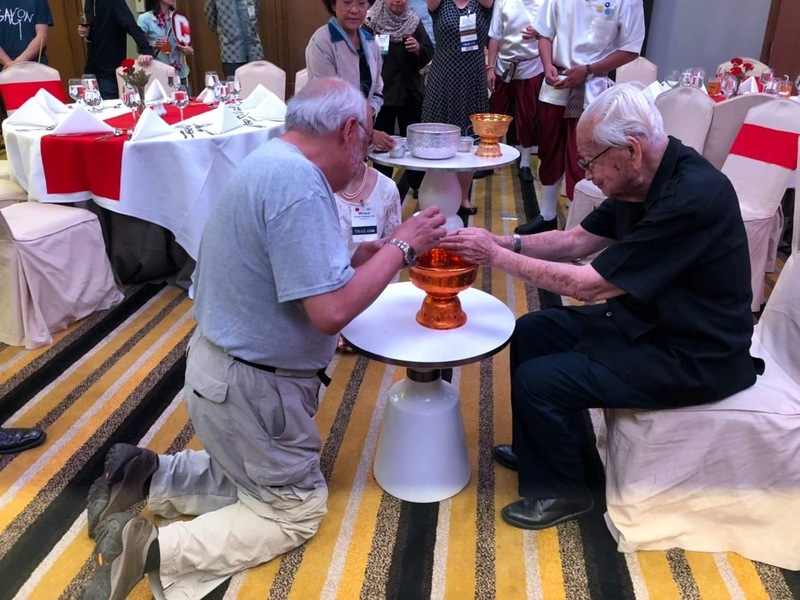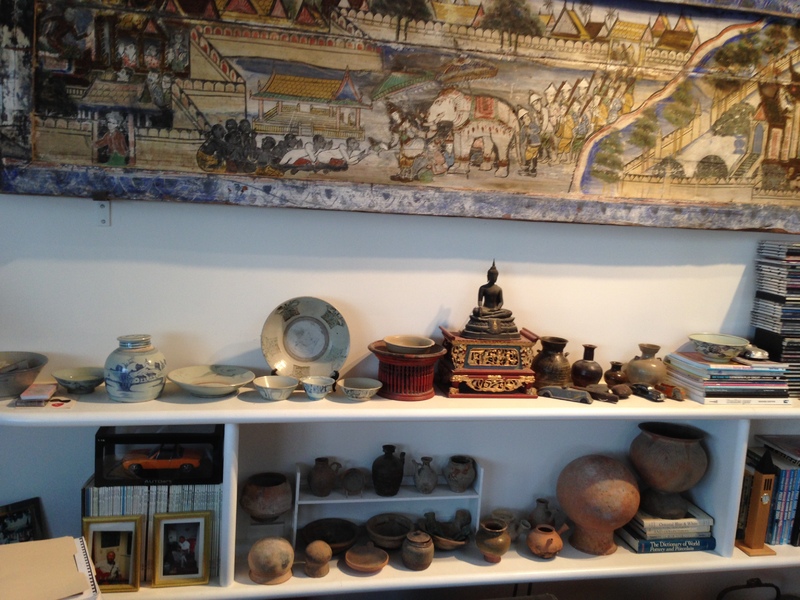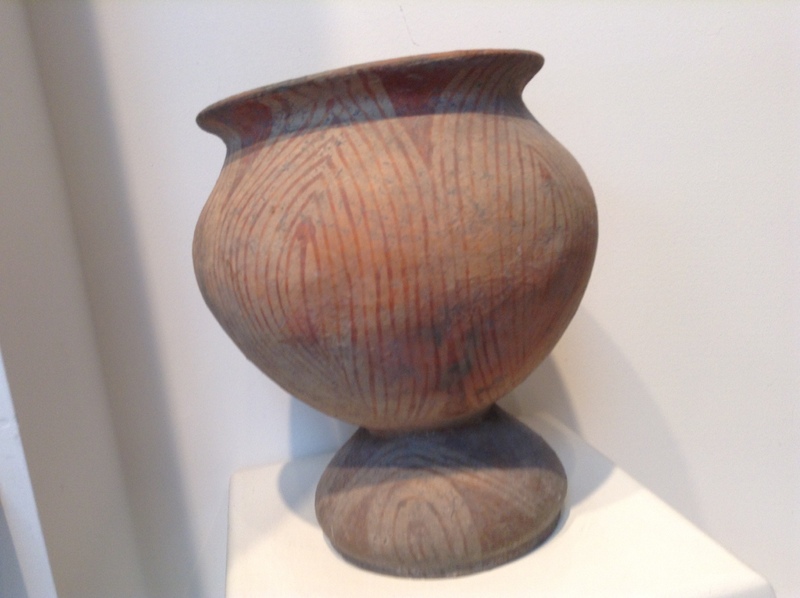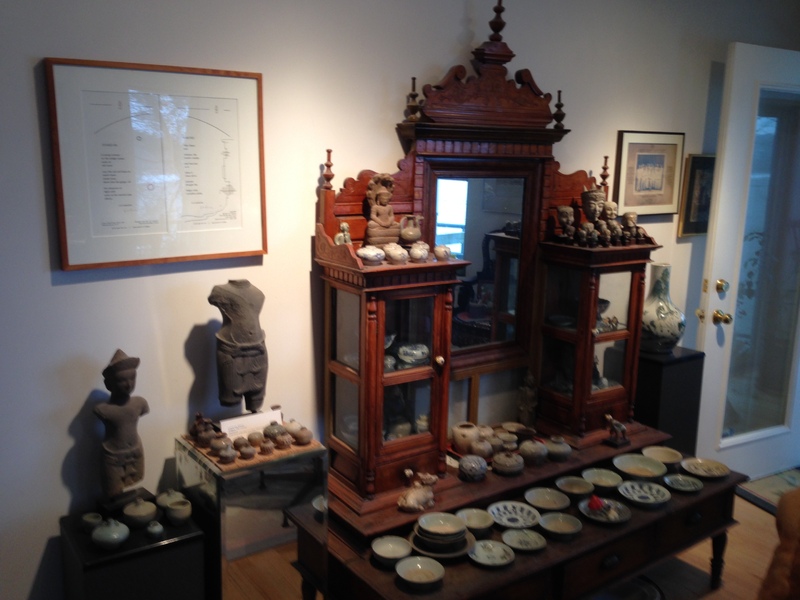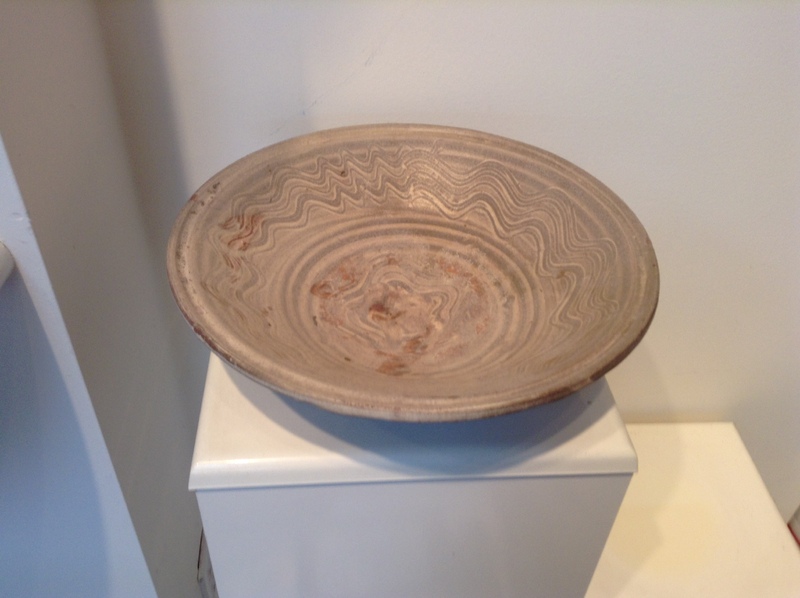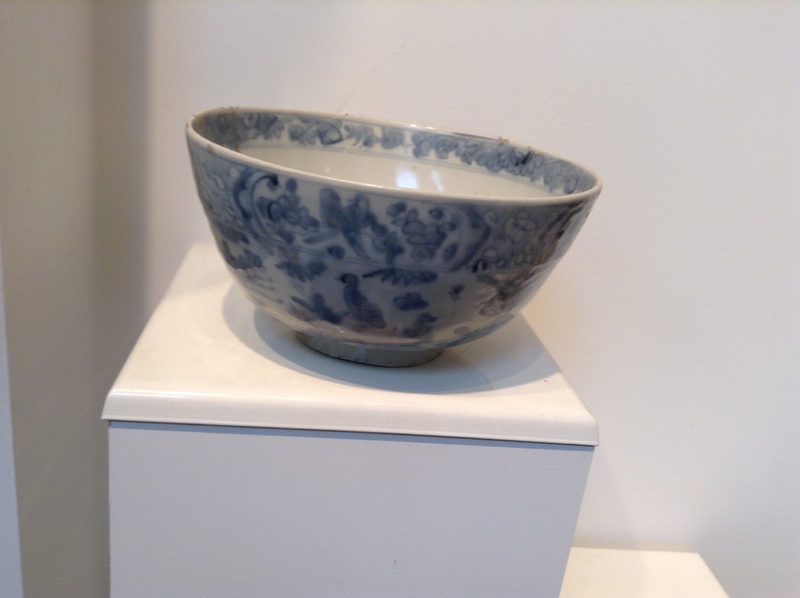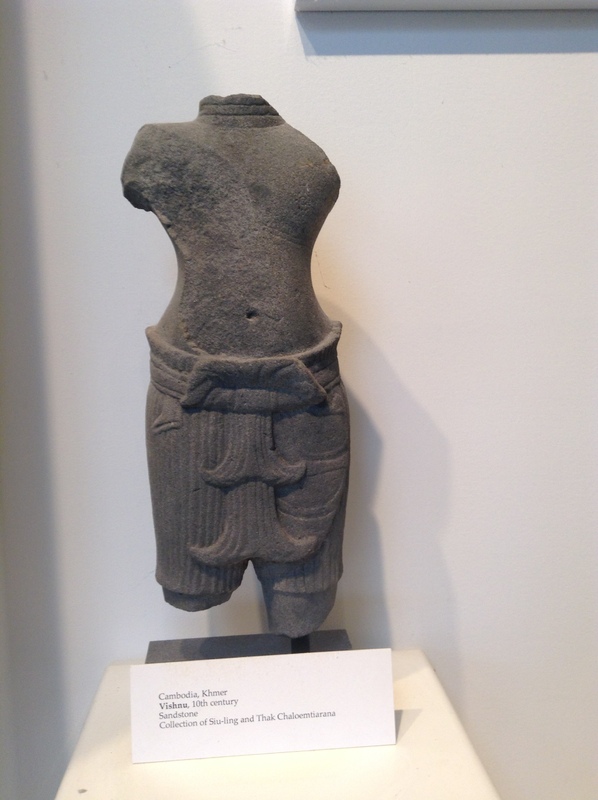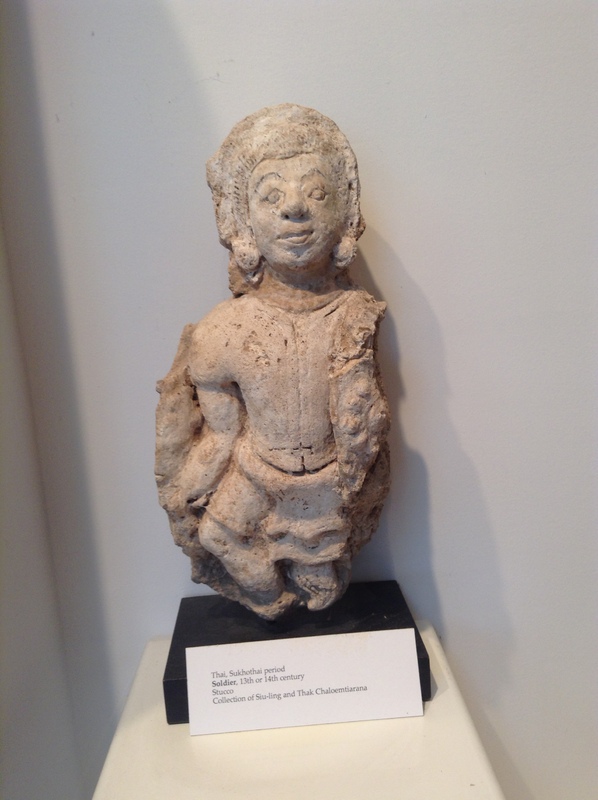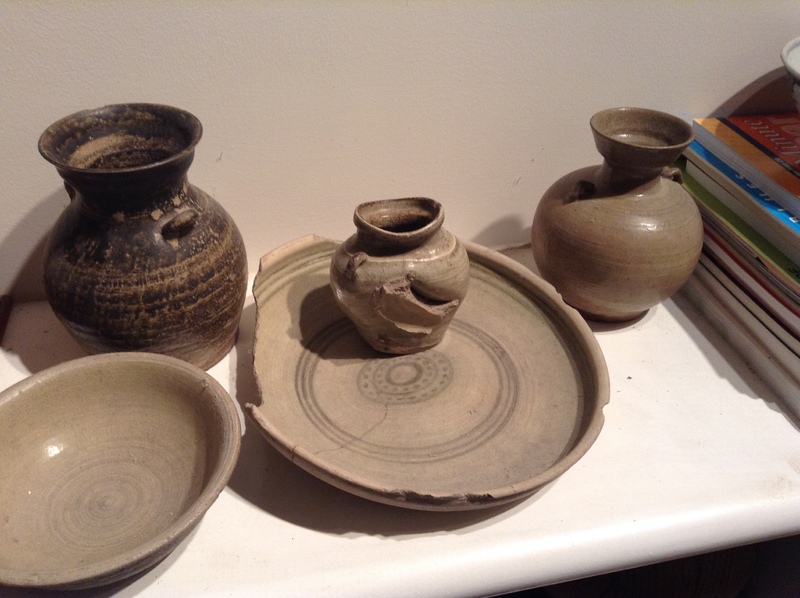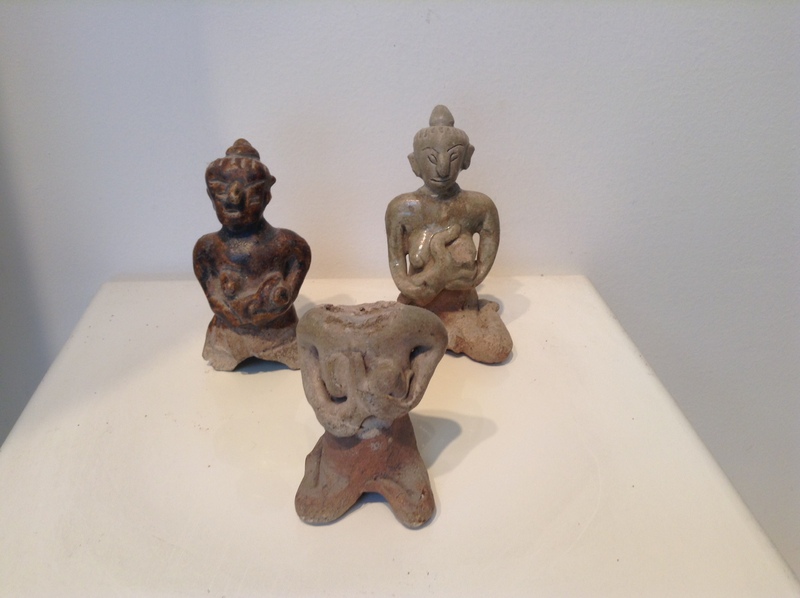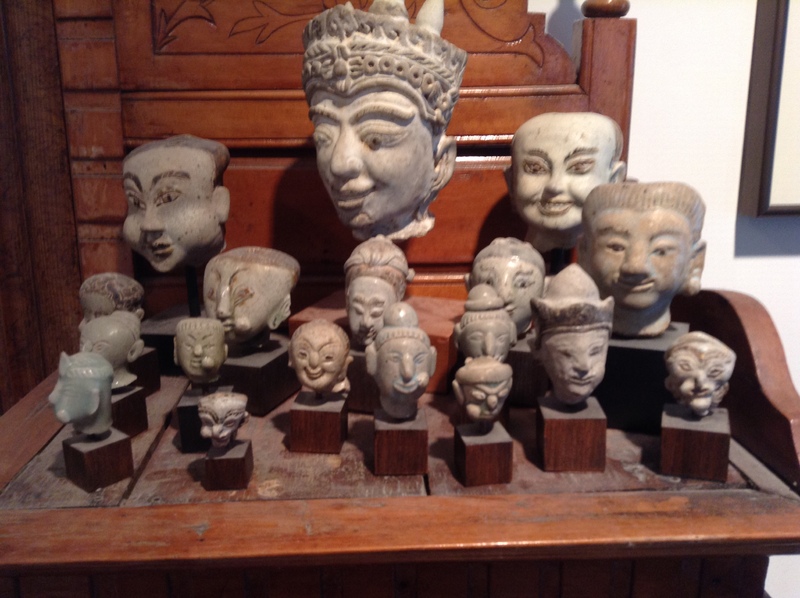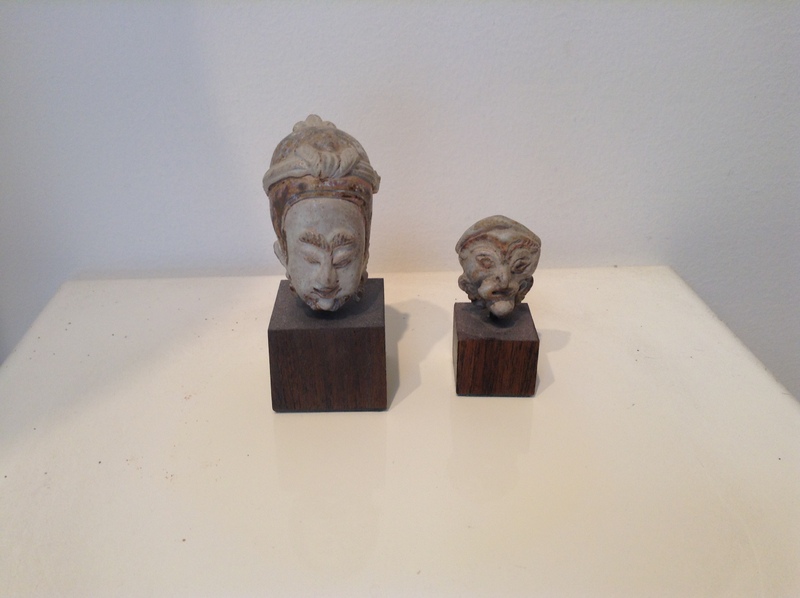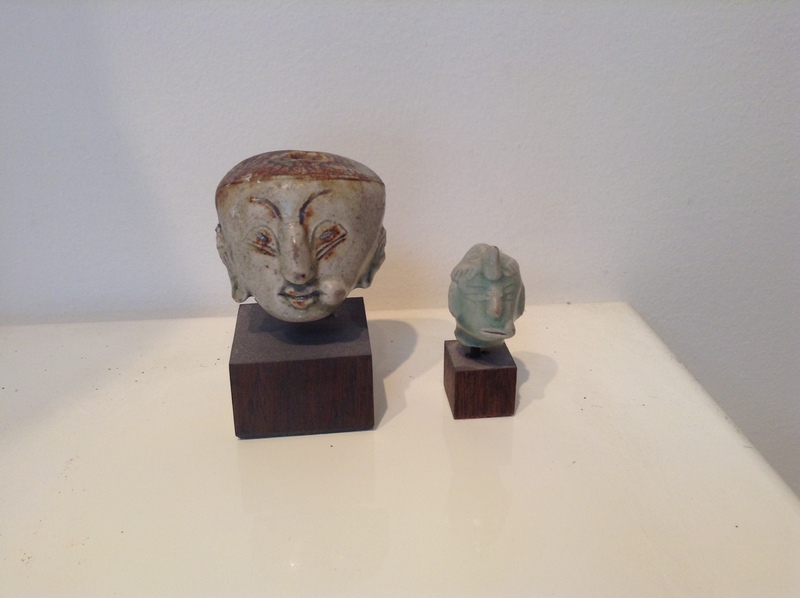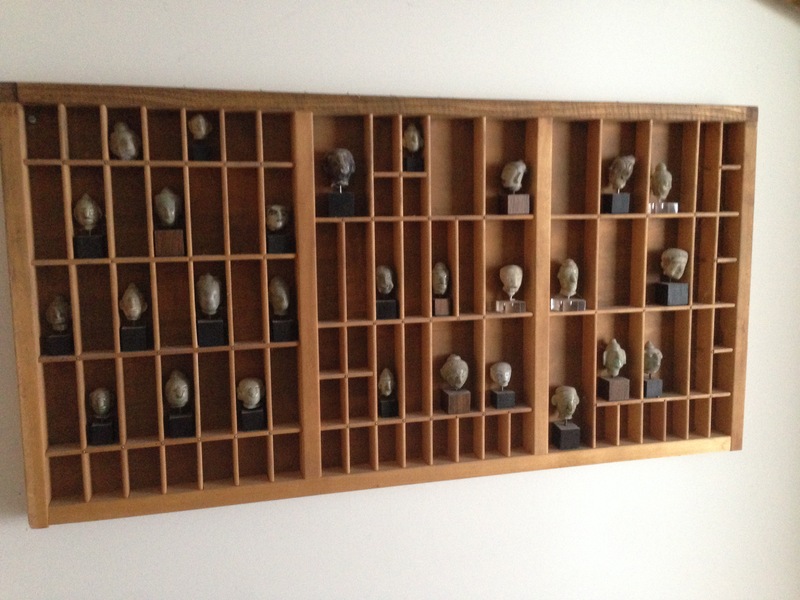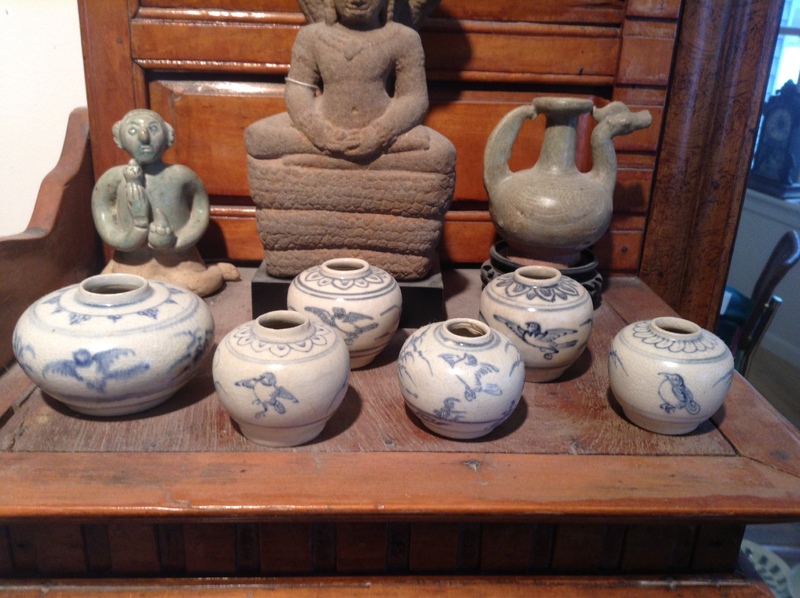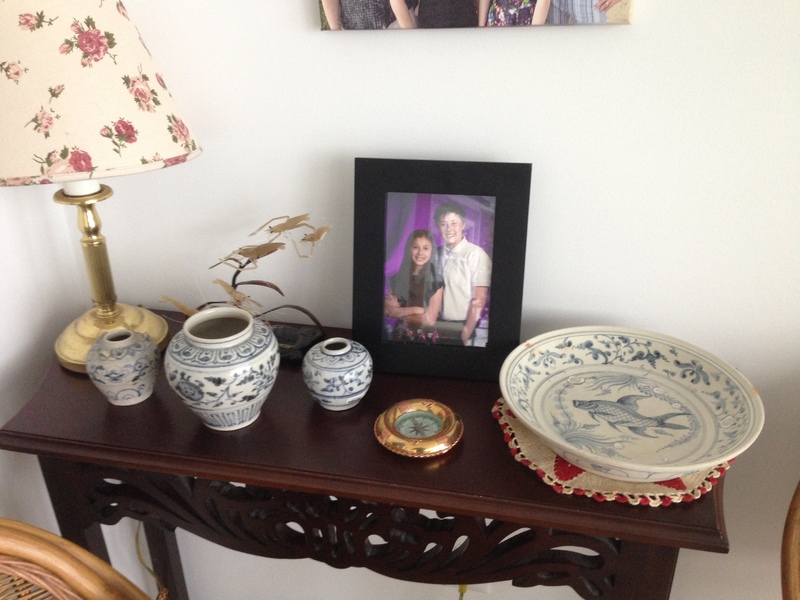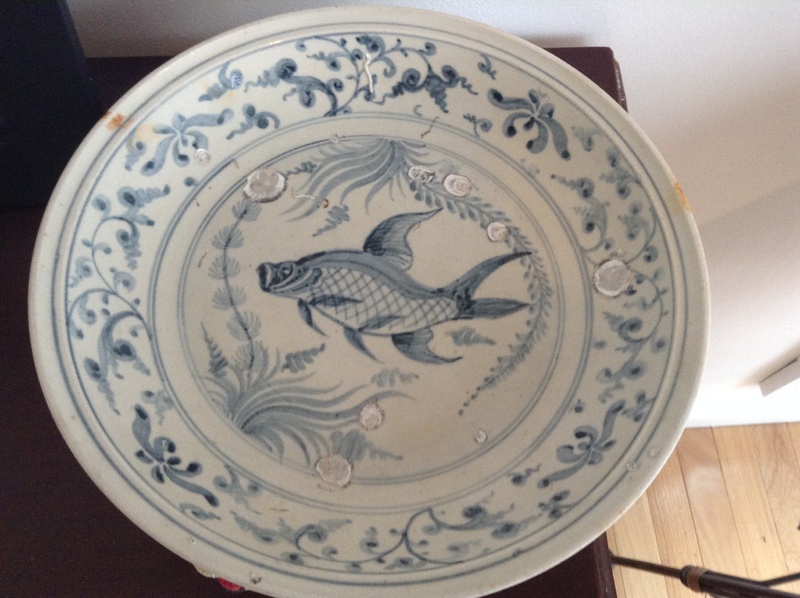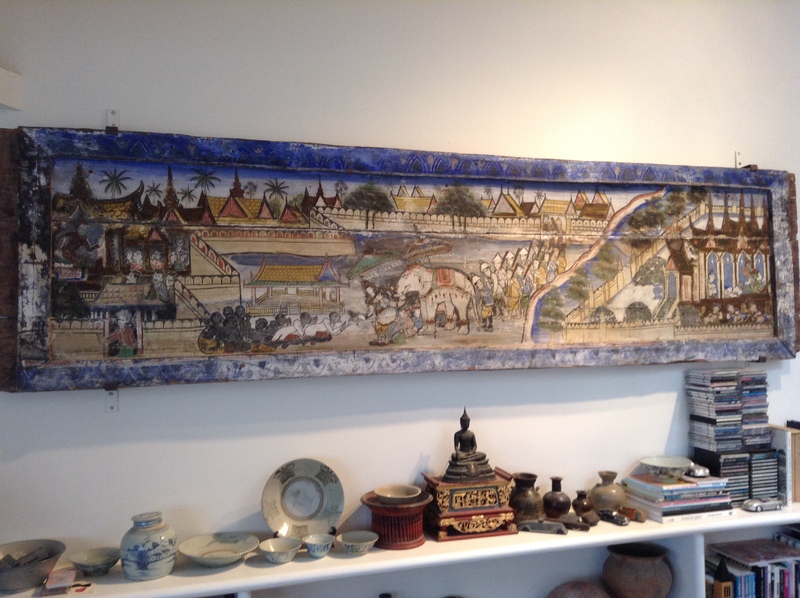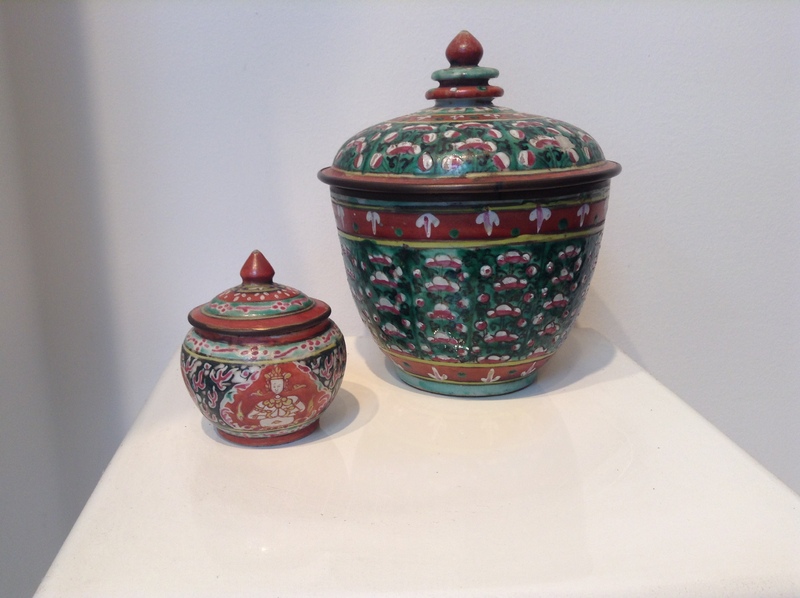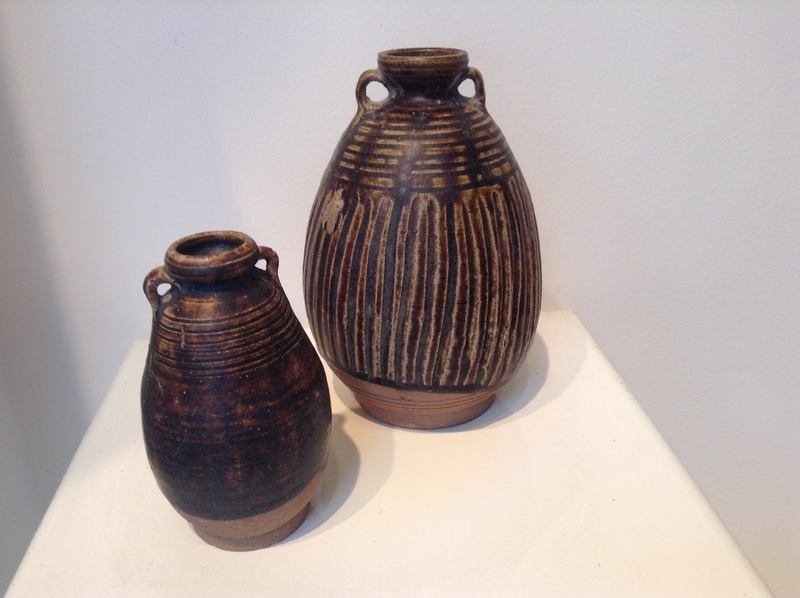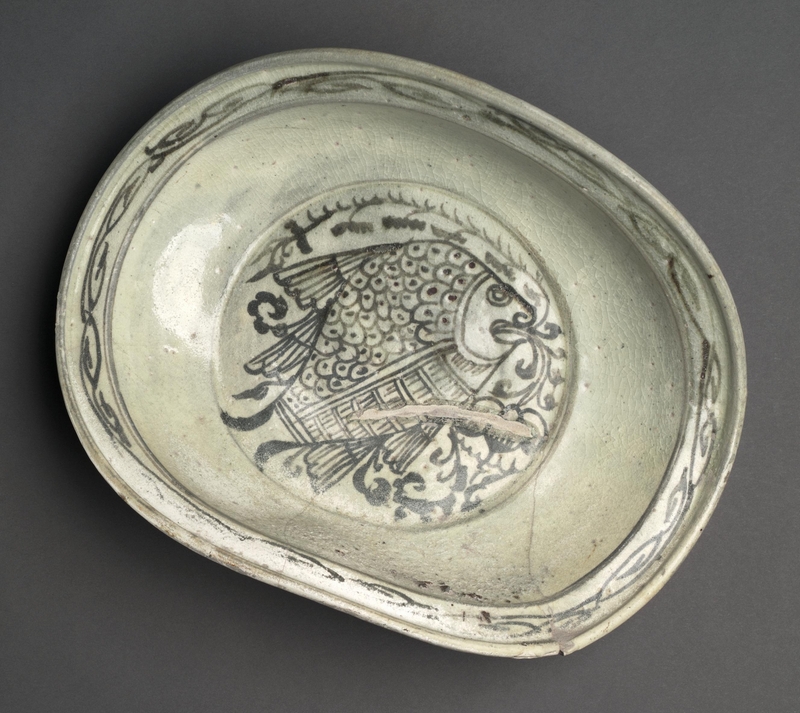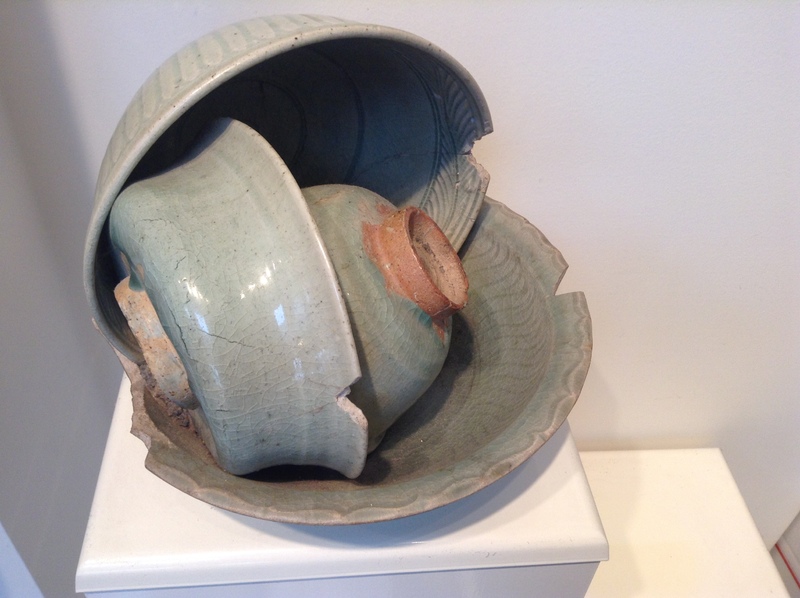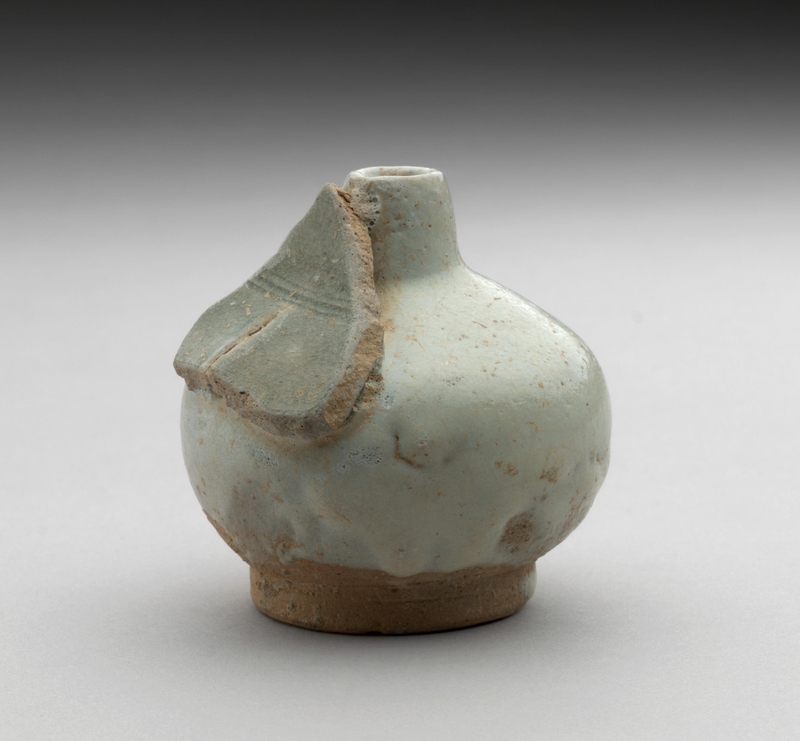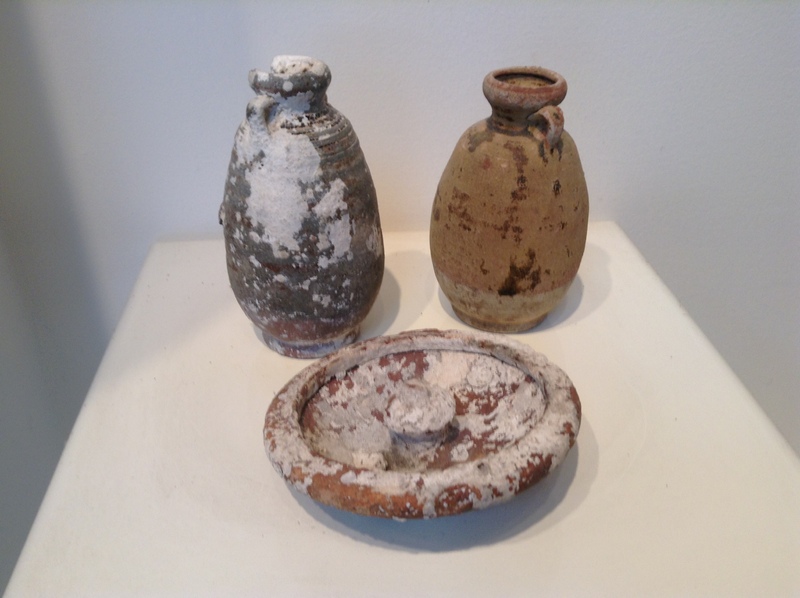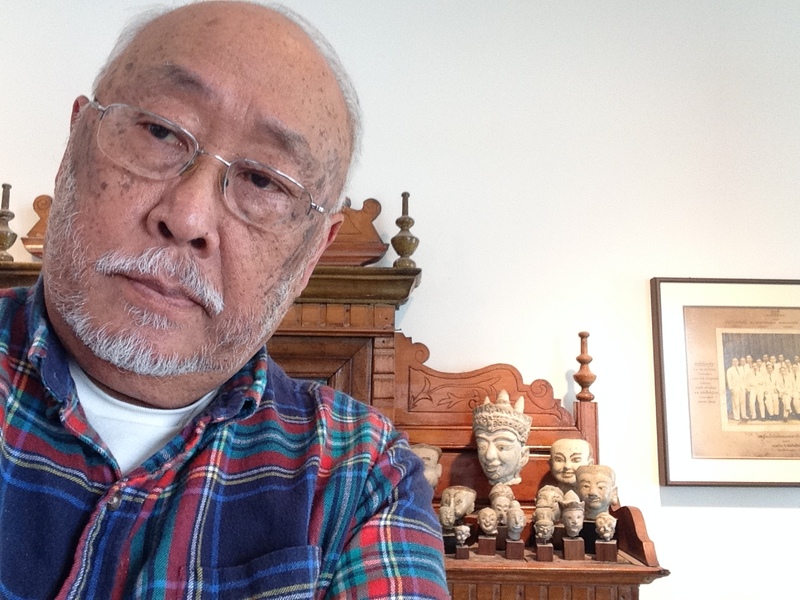A Collector's Life: An Interview with Ajan Thak Chaloemtiarana
By: Alexandra Dalferro
Ajan Thak Chaloemtiarana is a retired Professor in the Department of Asian Studies at Cornell University. He first visited Ithaca in 1967 and became a doctoral student at Cornell in 1968. Ajan Thak is the author of the critical political-historical study, Thailand: The Politics of Despotic Paternalism, and the recently published Read Till it Shatters: Nationalism and Identity in Modern Thai Literature. From 1998-2010 he was the Director of SEAP. Summarizing Ajan Thak’s wide-ranging contributions to numerous academic fields and spaces is impossible to do here, and interested readers can find further resources at the bottom of this interview. For now, we offer a glimpse into one of Ajan Thak’s hobbies and passions – collecting antiques from Southeast Asia. Ajan Thak spoke with Alexandra Dalferro over Zoom on October 21, 2020, about his experiences collecting. His description of the tukta sia kaban, or talismanic dolls who were created so that humans who sought to diminish their bad luck could break off the dolls’ clay heads and transfer misfortunes away, offers a powerful counterpoint to other sculptures featured in this exhibit like the Buddha heads gathered by Alex Griswold. Ajan Thak kindly provided images of some objects from his collections as they appear in his home, and they are interspersed with ceramics from Ruth Sharp’s collection at the Johnson Museum to highlight similarities and differences in ceramics made at the same kilns in roughly the same time periods. (Images without captions are photos of objects in Ajan Thak's collection)
Tell me how you became interested in collecting and antiques.
I became interested in antiques because of my father. He was consul general in Hong Kong in 1956, and I was a teenager back then. He would buy Chinese antiques, and he had an agent who would go to auctions and buy Chinese antiques. Back then a lot of Chinese ceramics were coming out of Mainland China, so my Dad had a few. They were large pieces - major ones. I knew about them and read about them and became quite interested.
Did he display them in your home?
Yes, they were in the house. All over the house. I’m jumping ahead a bit, but my children grew up with antiques in the house and they never broke any – amazing!
That is amazing! My mom has a small plate collection, and once I accidentally knocked one off the wall – I got in the biggest trouble of my life.
(Both laughing) My kids learned not to touch khong kao – antiques. When I was at Cornell, we had wonderful speakers, and one of the seminars was held at the Breezewood Foundation, which was Alex Griswold’s home. Graduate students would go there and have a seminar, mostly on Buddhist iconography and Thai inscriptions. Griswold and Ajan Prasert na Nagara wrote many things on Thai inscriptions. It’s funny – Ajan Prasert was a PhD graduate from Cornell in 1950, and his PhD was on statistics.
Oh wow! I didn’t expect you to say statistics.
He taught engineering and statistics at Kasetsart University and became Dean and Undersecretary of the University Bureau – he had a very interesting life. Back then they had just discovered a lot of Thai inscriptions but nobody could read them! So they had to send them to George Cœdès in Paris, and Ajan Prasert said, “Cœdès is getting old! We should try to read these ourselves.” That’s how he became an expert on reading Thai inscriptions, and he worked with AB Griswold.
Who did Ajan Prasert study with to learn how to read the inscriptions?
I have no idea; I think he’s self-taught. He was a very accomplished person; he was a musician and he wrote lyrics for the King’s [Rama IX, Bhumibol Adulyadej, reign 1946-2016] songs. He lived to be 100! I had the pleasure of meeting him just before he died, and I did a rot nam (water blessing) ceremony for him.
Anyway, when I was a student at Cornell of course art history was taught by Stan O’Connor – I never took a course with him, but I wish I did. I was so involved in my own little world trying to be a political scientist! But one of the things I remember clearly is when Dean Frasche came and gave one of the Thursday luncheon talks with slides – something I miss a lot! It was very informal and very informative. Frasche gave quite a few pieces to the Johnson Museum and he wrote a book on Southeast Asian Ceramics, Southeast Asian Ceramics: Ninth through Seventeenth Centuries. I learned about Thai and Southeast Asian ceramics from Frasche’s presentation, which got me interested. When I graduated and went back to Thailand to teach at Thammasat Universty in Bangkok, the Sunday market used to be held at Sanam Luang, a large grassy park near the Grand Palace and the Temple of the Emerald Buddha. Now the weekend market is at Chatuchak, but it used to be at Sanam Luang, right in front of Thammasat. People selling antiques would set up right across from one of the entrances to Thammasat near the ho prachum yai, the large auditorium. I would visit when I went to Thammasat on the weekend. I’d walk around and talk to all the sellers. At that time, they were discovering a lot of Ban Chiang pottery, and villagers would bring Ban Chiang pottery by the truckloads and unload them right at Sanam Luang. A few people knew about that. I didn’t have much money – I was a civil servant, you know, you never have any money! (laughs) But I was so annoyed that a lot of people from embassies, European embassies, the US embassy, would go and buy up all the Ban Chiang pottery. They didn’t do any bargaining, and they would take the whole lot, hundreds of pieces. I was so annoyed that I gritted my teeth and bought ONE piece (laughs). I bought one. And then I thought well, maybe I should do more. So I slowly bought little things, and started to collect things.
Luckily my wife Siu-ling taught at the international school, so she was paid an American salary, which helped! (laughs) And so I was able to use part of her income. First I bought Thai ceramics -- little ones, little jars, for five baht, ten baht. Like Sawankhalok. And I went to Sukothai and bought some there too. I also bought a lot of local Ming and Qing and even Yuan Chinese ceramics. These things have been around for a long time in Thailand. The Chinese brought them, but the Thais used them in their houses.
Did you recognize any of those from your father’s collections?
No, these are mostly export ware, what they call common Qing or Ming household ware – they’re not imperial ware. The stuff my father bought was imperial ware and very expensive. These were daily utensils but they’re very nice. They cost 100, 200, or sometimes 500 baht. So I started slow… (laughs). My brother-in-law had a furniture store inside Wang Suan Pakkad, the palace where Prince Chumbhotbongs Paribatra lived (Prince Chumbhot was also friends with Alex Griswold. He was a defense minister who almost became king, and my brother-in-law’s aunt was married to Prince Chumbhot’s son; she was the owner of the palace. The palace is on Sri Ayutthaya road in Bangkok, and now it’s a museum. We used to go to Ayutthaya province to eat, and I discovered that people were diving into the river off piers and docks around there and coming up with Chinese ceramics!
I suspect that during raids by the Burmese, people would throw these things into the river and wait to recover them. The divers were bringing up pretty nice Chinese stuff, like Qingbai white ware. We didn’t know what to do with it. So we thought, “Hey, why don’t we sell some of these.” I did the research and wrote up little descriptions and then sold them at Wang Suan Pakkad, which has always been visited by a lot of European diplomats. They bought everything that I had! I should’ve kept some. With that income, we would go out and have a banquet… so we ate whatever profit we made! (laughs) We had nothing left. That was part of how I became a dealer – dealers aren’t supposed to keep anything, you’re supposed to sell, or else you can’t be a dealer.
Did you buy the ceramics from the divers? Did you yourself ever dive?
No, no, I bought them from the divers, and from antique stores that I knew. The blue and white bowls that you can find, that you see around the temple near Thammasat – the monks would be selling these things! So I have all these little bowls that you buy for thirty baht each. And I’d give them away as gifts. What happened next is that when I was teaching at Thammasat, the Vietnam and Cambodia issues were going on. In the mid-1970s, the Khmer Rouge looted some provincial museums, and they brought out a lot of small stone carvings. They were selling them at the amulet market at Thammasat, still with the museum acquisition numbers written on them, but they would try to scrape those off. I thought to myself, “My God, this is crazy.” So I bought a few, and I still have quite a few myself. I don’t know what to do with them and I can’t figure out where they are from. When I became more serious, I started to buy antiques from this antique dealer on Silom Road. The store is called Chai Ma. And Chai Ma also sold antiques to Professor [Lauriston] Sharp! Out of the blue, I’m buying this stuff and he said, “Where are you from?” And we talked and I mentioned Cornell and he said, “Oh, do you know Professor Sharp?” And I said yes, because Professor Sharp was on my committee! My committee at Cornell was comprised of Ben Anderson, George Kahin, and Lauriston Sharp. (laughs) In fact Chai Ma’s son also came to Cornell later as a graduate student, but I didn’t know him.
Anyway, Chai Ma sold me more expensive stuff. I bought stuccos from him – I like stuccos. I got a few stuccos from the Dvaravati-Mon period, from the eighth and ninth centuries. They are not major pieces. He also sold me Khmer and Mon bronzes. I don’t have many, just three or four. Some of these were exhibited at the Johnson Museum when they held the exhibit “Ithaca Collects” in 2008. Ellen has come to my house and looked at things. I remember one of my very nice stuccos from the Sukothai period and some Khmer stone statues and bronzes were exhibited then—
Just a quick question going back to Chai Ma – how did your relationship with him work? Would he call you when he had things he thought you would like?
I would just drop by. He was a very smart business man. He would always tell me, “Oh just bring it home and look at it for a while! If you don’t like it you can return it!” I never returned anything that I took home. He was so smart! I’d take it home and look at it and get attached to it.
When I left Thailand, a lot of these things were not allowed to be shipped out. They didn’t care so much about the Chinese stuff. I have a strange collection from when I was visiting Ajan Shalardchai Ramitanond and Ajan Jim (Virada Somsawat) in Chiang Mai. They are both gone now. But he said, “Hey, want to go and visit a place, a village in Sankamphaeng called Ban Orn?” So we went there, and in the middle of the temple, there were remnants of kilns. These are called Sankamphaeng northern ceramics, and they date back to the fourteenth and fifteenth centuries. When we went there, we encountered some Japanese collectors digging up these things. The Japanese are great collectors of Thai ceramics. We started competing with them. There were sherds all over the place, and we were picking up sherds and picking up kiln waste. Do you know about kiln waste? When you fire things, sometimes they get stuck together, they’re very warm, and the firing goes wrong. I have some kiln waste from Ban Orn, and I asked the villagers if they had anything they wanted to sell us, and they did! I have some very nice pieces, like a few vases, and I think I have four very heavily potted jars that they used to store salt. Some of them are very pretty and some are not, because they are utilitarian things. Today we think of them as “art” -- but back then they were just things that people used. I have those, right from the site! The second time I went back to Ban Orn, there was nothing left – the Japanese took them all. (laughs) That was just by luck!
When I came back to Cornell, I slowly carried things out with me, and now I have my collection here. Another interesting collection that I have and I used in classes are tukta sia kaban. Have you ever heard of tukta sia kaban?
No, you mentioned that before in your email and I’ve never heard of them! I’m very curious.
Tukta, you know, the Thai word for doll. And you know kaban is Khmer – for head. So these are “dolls that lost their heads.” They are figurines with meanings tied to animistic beliefs. I noticed that most of the figurines are women holding babies, or men holding fighting cocks. Some have very strange facial features. They were used during the Sukothai period, but not so much during the Ayutthaya period, and they have been found at Angkor. People would buy these roughly made figurines, and they would pray and then they would decapitate the doll. That’s why they are called tukta sia kaban. They knocked the heads off, which means they transferred all their bad luck away. Maybe the bad luck could occur during childbirth, or when going to war, or if you said bad things to your cockfighting opponents… so you kill the doll.
It is hard to find an intact doll. But I saw some, and later, I found a vendor who had been digging around and found a whole pit full of the heads! They are small, some are big but usually they are very small. I bought a whole bunch of them, and I have some of the torsos.
I have a bunch of heads because they depict different hairdos and different features. Some have bulges in their cheeks because in the North people liked to gin miang – they were chewing fermented tea leaves. I used them as an example of material culture in my classes, and I’d tell students that by looking at these heads, we can kind of see what people looked like during that time. One head in particular has really strange facial features; its face is all screwed up. I didn’t know what it was, and I did some research and I came across a picture of somebody with leprosy. In the picture, the sick person’s face looked just like some of the tukta heads that I have. This means that people with leprosy or who were afraid of getting leprosy were buying these and decapitating them so that they would not fall ill. I have one another one that is quite unusual. It is very pretty and it looks like the head of a Chinese monk. The detail is so amazing that I think it was made by a Chinese artisan. One of the theories that people have about Sukothai is that when the king sent tribute missions to other kingdoms, one of the things that they returned with was pottery. People suspect that Chinese potters and artisans also came back with the tribute, and they taught Thai potters their techniques. In Sukothai there is celadon, but no blue and white ware.
I have one more question about the tukta. What are the torsos like? Are they wearing clothing or are they just rough body shapes?
No, just very rough shapes. I do have one that is intact which is quite hard to find. At some point, I will show you some pictures of all these stray heads. The tukta were transformed into clay figures during Ayutthaya period. They were used as little figurines at san pra phum – spirit houses. Even now when you go to spirit houses, you see these. Or you go to shrines and see the little figurines.
Then I came back to Ithaca, and it was hard to buy anything. I would go back to Thailand every year or every other year and buy a few pieces and bring them back. My collection continues. My collection also expanded to Vietnamese wares. Vietnamese wares were present in the Thai market, but not many. Later, a lot of Vietnamese wares were smuggled out from Vietnam. Bangkok is the center of smuggling artifacts, right? It is the center where you buy all the stuff…it’s horrible! Once I saw these interesting little jarlets with sparrows on them and I bought a few. Right now, some of them are on display at the Johnson in the Vietnamese case on the fifth floor.
Eventually, I found out that some of these came from what is called the Hội An Hoard, which is a Vietnamese trading vessel that sunk in the South China Sea and has been dated to the fifteenth century. A lot of Vietnamese blue and white ware were discovered there in the early 1990s, and several catalogues have been written about the ceramics from the hoard.
Some of them went to museums in Vietnam and the rest were auctioned by Butterfields in San Francisco in 2000; the Vietnamese Salvage Agency, Saga Horizon (a cargo ship/company), and the Vietnamese Ministry of Culture divided the profits from the auctions. You can still find them once in a while on EBay because they have the little label on the bottom that says, “Hội An;” I’ve bought some from EBay just for the heck of it, but most from Thailand. A few years ago, I actually went to Hội An and walked around the market and found a shop that was selling these things! They were quite expensive. I was able to buy one, a plate, just for the heck of it. Since I was actually in Hội An I figured I might as well buy something there, from there.
At my house, I have a large painting that depicts scenes from the pra vetsandon, the Vessantara Jātaka. The painting came from the North, from an old, dilapidated temple. It is a couple hundred years old. Back then, monks or amateur painters painted the whole scene on panels of teak for the temple. Every house I’ve lived in must have a big wall to hold that darn panel! (laughs) It has followed me all over! It’s huge!
You shipped it out of Thailand?
This is an interesting story. When I wanted to ship it out of Thailand, the shipping company said, “Oh this is heritage, you can’t just do this. You have to get permission from the Fine Arts Department.” So I contacted FAD and they said, “Well you know, this is heritage stuff, but its peun ban, common stuff.” I said I would donate it to a Thai museum, but first they had to promise me that they would store it nicely and not throw it away. But they have nowhere to keep the stuff! (laughs) I told them that this painting was something for my family and I was going to America, and I’d like to have something like this. Then they said I could keep it, and I was able to take it out with me. If you’re Buddhist, they allow you to take out Buddha images and so on, and this is semi-religious. So I got it out.
You mentioned earlier that some of your other pieces had certain heritage protections; have you been able to get those out too?
I hate to admit it, but I brought one Ban Chiang piece by myself. Back then, a lot of these were on the market and I knew people who had them and they didn’t know what to do with them. Thai people are quite afraid of the ceramics – these things are grave furniture! I had some friends actually give some pieces to me. Ajan Charnvit Kasetsiri’s brother, who was my roommate when I was in school in LA, had some and asked me if I wanted them. He gave me a couple, and sometimes I would just carry them with me because people wouldn’t know. I’d just carry them in a big paper bag on the airplane. Of course, now these items are closely watched and often repatriated; I know the Johnson Museum has a few pieces and I’m not sure what they will do with them. It’s hard to prove where you got them and so on. I left the piece I bought myself in Thailand, and I have two large pieces that are not broken, they are perfect. I’m not sure what to do. I will probably give them to the museum. And I have other little pieces from Ban Chiang period too.
Do you have any of the small rollers?
I have one roller. A lot of people weren’t collecting the rollers. I even bought some glass beads that I strung up for Siu-ling. They are those turquoise glass beads. She has a whole necklace of them!
That’s a very special necklace!
It’s just crazy. I have a lot of fun collecting. So I know quite a bit about ceramics.
How much of your collection is still in Thailand? Is it still split up or do you have everything here?
Most of it is here. I have some Bencharong porcelain from the late Ayutthaya to early Bangkok period. They reproduce that now, but I have some of the old ones. And I have some Chaliang ware (Si Satchanalai/Sawankhalok brown-glazed wares). Ruth Sharp has a nice collection of sherds. I think she had some from Wiang Kalong, the Northern kilns. More than 200 kilns have been found around Kalong to the east of the Mae Lo River, halfway between Chiang Mai and Chiang Rai. Very few Northern kiln things survive.
And I told you I have the stuff from Ban Orn, Sankamphaeng, which are quite different – the potting is thin, and that’s why they always distort and go bad. They are either dark brown or semi-opaque celadon. Kalong ware is different – Kalong is underglazed with iron, so it is black and the painted designs are large.
Did you ever speak with Ruth Sharp about her interest in collecting and her objects?
Not really. But back to the collection, when I was teaching, Stan O’Connor would give a lecture on ceramics at the museum for my class. My students were so impressed, because they got to hold and touch real Sawankhalok ceramics. You have to feel these things – you have to be able not just to see them, but you have to feel the glaze and the clay. And then you can recognize the type of clay and all the different marks.
Did you involve the collections in your teaching in other ways?
Mostly with ceramics. But I did the exhibition “Ithaca Collects” with some of my stone ware and bronze ware.
I’m curious about how you display your collections in your house; how are they set up? Are they all on display?
They’re all on display. They are all over the place. My kids grew up with them. I plan to give most of it to the museum, but my kids probably want to have first pick. They want to take some pieces that they like, which is OK.
The historically important ones are the kiln waste, which the Thai authorities are strict about taking out of the country. I have a very nice, large piece from Sawankhalok Sukothai, and it is about five or six beautiful celadon pieces stuck together. Kaja [McGowan] borrowed it once to use in her class.
Oh! Another thing I did which is crazy – to go back to talking about diving for these things. My sister has a compound at Samae San, which is near Sattahip in Chonburi province. Samae San is a fishing village and group of small islands. Between these islands, there is a channel where all the boats pass through. We heard that there were some Sukothai-period potteries and jars that had been thrown overboard. Some of them were broken. These things that today are viewed as very valuable, expensive artifacts, back then they were used to hold – I don’t know what they actually put in them – maybe nam pla (fish sauce) or whatever! (laughs) Just like how today, people throw random glass bottles into the ocean. When the tide is down, I went out with my brother-in-law and we snorkeled – we didn’t have scuba gear, we just snorkeled for it. When the water is low, the channel is only about fifteen or twenty feet deep. We actually recovered some of these! These little jarlets from Sukothai period, encrusted in shells and stuff. So my history with all the ceramics goes that far!
Goes that DEEP!
Yes deep! I dived for these.
Did you keep those jarlets?
I kept some. I have a few, one or two. My brother in law has more. We brought up those large jars too. I don’t know what they used to put in them.
Are your children collectors too? Has your interest been passed to them?
No, no… they probably see their parents do crazy things and decided not to. I also have a large collection of guitars… and a large collection of bamboo fly fishing rods… crazy!
What kinds of daily care and attention do your objects require? Like the ways you clean them or engage with them on a more regular basis.
Not much… I dust them off a little bit. Oh, I have a few Buddha images too. One is Shan, from Shan State. It’s a large one, about two or three feet tall. I’m told it is from the eighteenth century but I’m not sure. It only has the lacquer left; all the gold gilding is gone. And then I have one reclining Buddha carved from soapstone that’s Burmese. It is very nice. It is heavy as heck! I carried that out on my back in a backpack! (laughs)
Where did you find that one?
I found this at Chatuchak. You know Chatuchak has all these antique dealers as well.
Yeah! I like to look around in that section.
It’s not as much fun as Sanam Luang, where the villagers would bring their stuff and just sell them.
Was Sanam Luang set up like Chatuchak? With rows of vendors, or was it more makeshift?
Chatuchak is all built. You have places for each vendor. But Sanam Luang was free for all. So they would just put things on mats or little tables, because it was only for two days. Back then, the whole Sanam Luang was full of vendors. I hope they open it up again. It’s really bad now. When I was young, we went there often. That’s where a lot of Thai kids learned how to ride a bicycle, because they could rent bicycles there, and lots of people were selling food. Even during my time and my father’s time, it was where you went for kite fighting – chula pak bao. These were huge kites! I would go there and my dad would go there and we would watch the kite fighting. So that’s gone… hopefully they will bring it back. There’s a lot of clamor to bring it back.
Another thing – at the Kahin Center there is a standing Buddha. I think that one is from Griswold. In the glass case, there is a bronze sitting Buddha. That was given to us by Professor Harold Shadick, who was a China expert, but he was in Thailand and somebody sold it to him there in the 1950s. And that Buddha image sat in my office at Uris for years! I was afraid that something would happen to it, so I moved it to the Kahin Center. But it is still kind of kicked around like it’s just a decoration or something. Horrible!
We didn’t think about looking at the art at Kahin! That’s a good idea. You have some Chinese propaganda posters hanging there too, right?
Those are banners – Mao banners. It’s a weird story too. I used to go to this antique show called Salt City Antique Show in Syracuse. I would go there just to look at things and I saw these banners! Lots of them came out of China in the 1960s. They were just rolled up and some were torn. I bought those two that I could afford. In fact, those banners were also exhibited at the Johnson Museum when they had an exhibition on Mao badges and posters. The descriptions next to them come from that exhibition. And Carol Rubenstein gave us that Dayak painting on the second floor. She gave another one to the museum that was the cover on one of the SEAP bulletins recently. And we have that real one on the second floor of Kahin Center.
I really miss looking at that painting – its right outside our office.
Yeah!
This makes me miss Kahin a lot.
I’m not allowed there – I’m not “essential staff.”
It’s hard. The pandemic is exhausting in so many ways. Thanks so much for talking with me today Ajan. I might follow up with you on some things later if you don’t mind.
I can send you some pictures – just iPhone pictures – of some of the objects we discussed.
Yes, that would be great!
I used to have grad students come to my house twice a year when I was Director and after that too. I would give a lecture on Thai and Southeast Asian antiques. But I haven’t done that in years.
You don’t want to give one over Zoom!?
(both laughing)
We will figure something out. Some of my pieces were on the covers of SEAP Bulletins. Some Burmese and some Thai objects. Some of the old Bulletin covers were art pieces too. We owe the Bulletin to Stan O’Connor’s insistence. He said we should have a Bulletin worthy of the program! Ours is always first rate and we must keep it that way.
It remains a beautiful thing to read.
Ajan Thak took this selfie in front of his tukta heads. The photo that is half-pictured is of the Thai delegation that negotiated with the French to return Khmer provinces to Thailand in 1941; Ajan Thak’s father was a member of that delegation.
Read more about Ajan Thak here:
“Interview with Thak Chaloemtiarana.” Interview by Nicholas Farrelly. New Mandala: 19 October 2007. https://www.newmandala.org/interview-with-thak-chaloemtiarana/
